Mustafa Sener's battle against chaos
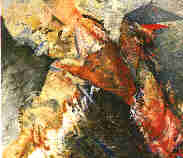 The recent paintings by Mustafa Sener show us a battle, a
struggle against disintegration and chaos.
The use of paint is a violent one. Vigorous brushstrokes and
splashes. Sometimes Sener lets the paint drip.
The colors are mostly dark ones: earthy tones combined with
blue. The dynamics are not focused toward one point, but rage
like a whirlwind across the canvas.
The recent paintings by Mustafa Sener show us a battle, a
struggle against disintegration and chaos.
The use of paint is a violent one. Vigorous brushstrokes and
splashes. Sometimes Sener lets the paint drip.
The colors are mostly dark ones: earthy tones combined with
blue. The dynamics are not focused toward one point, but rage
like a whirlwind across the canvas.
Amidst this pictorial fury, vague geometrical forms appear. But
the straight lines become eroded and the plain fields are
overgrown with nervous cross-strokes. Mathematical clarity and
cool abstraction are threatened to get the worst of it.
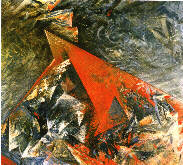 Mustafa Sener's work can be placed in the tradition of the
abstract expressionistic painters that originated in America in
the late 1940's.
Mustafa Sener's work can be placed in the tradition of the
abstract expressionistic painters that originated in America in
the late 1940's.
Characteristic of this trend is the emotional treatment of the
material. The emotions of the artist are not translated into
symbolic scenes as was the case with the surrealist painters,
but unload themselves into the physical action of painting.
Disregarding the fact that Sener sometimes works for months on
one painting, his works carry the traces of the physical action
of the making as such.
Robust strokes and nervous scratches succeed each other. It
certainly is not a coincidence that Sener sometimes, as the
'action-painter' Jackson Pollack (1912-1956), lays down the
painting on the floor to allow himself more freedom of movement
and to be able to check the effect the paint is having.
Intuitive
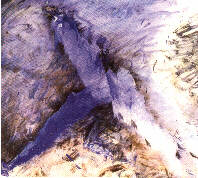 Emotions find their way out in spontaneous actions, but these
are intuitively guided by the eye of the artist.
Emotions find their way out in spontaneous actions, but these
are intuitively guided by the eye of the artist.
Because to take one's distance and to observe frequently plays
an essential part in the process of creation.
Likewise Mustafa Sener is not only the creator but also the
first spectator of his work. He reacts to what happens on the
canvas, attempts to answer the questions the painting puts to
him.
Thus the picture seems to dictate its own form. Yet the result
is indissolubly connected with its maker, because unconsciously
he bares his soul to it.
Through the painting in process of formation he indeed
communicates with himself, with the deepest layers of his
unconscious self.
Paradox
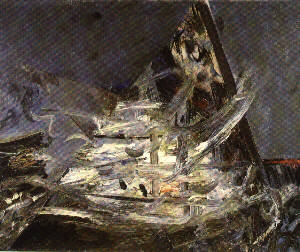 Mustafa Sener's work clearly shows a development. The paintings
that he makes in the 1970's are more or less static. Geometrical
forms predominate and still keep control over movement and
restlessness.
Mustafa Sener's work clearly shows a development. The paintings
that he makes in the 1970's are more or less static. Geometrical
forms predominate and still keep control over movement and
restlessness.
A small painting from 1977 has a triangular form as its main
feature. Wild strokes of paint attempt in vain to strike at the
hegemony of this symbol of harmony and equilibrium. Striking
fact is, that the composition seems to carry on outside the
framework of the painting itself.
In 1987 his work radically changes character. The restlessness
increases, but at the same time the composition becomes
stronger. Because of this paradox the tension increases. While
the former work usually shows an apparent arbitrary cutout piece
from a larger whole, now, the source of the conflict takes a
central place in the painting.
It is conspicuous that the geometrical forms are now sometimes
completely nonexistent.
Landscape
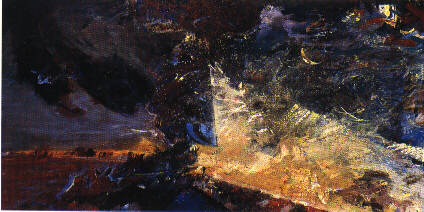 The latest, very remarkable development is that in the most
recent work there is a suggestion of space, by which the
dramatical effect of the picture increases.
Not only can we distinguish fore- and background, but also
landscape associations become possible. A big horizontal canvas
from 1994 makes you think of a gloomy sundown over a desolate
primordial scene.
The latest, very remarkable development is that in the most
recent work there is a suggestion of space, by which the
dramatical effect of the picture increases.
Not only can we distinguish fore- and background, but also
landscape associations become possible. A big horizontal canvas
from 1994 makes you think of a gloomy sundown over a desolate
primordial scene.
In this the painting constitutes an anti-pole of
sunrises-over-sea by the romantic painter William Turner
(1775-1851), an artist for whom Mustafa Sener has the deepest
respect.
Mustafa Sener's struggle has not ended yet.
Eagerly we can look forward towards the continuation of his
battle against chaos.
April 1995 Sietse Postma
Mustafa Sener's Curriculum Vitae
This site has been visited  times since June 8 1996.
times since June 8 1996.
 Mustafa Sener's work can be placed in the tradition of the
abstract expressionistic painters that originated in America in
the late 1940's.
Mustafa Sener's work can be placed in the tradition of the
abstract expressionistic painters that originated in America in
the late 1940's. The recent paintings by Mustafa Sener show us a battle, a
struggle against disintegration and chaos.
The use of paint is a violent one. Vigorous brushstrokes and
splashes. Sometimes Sener lets the paint drip.
The colors are mostly dark ones: earthy tones combined with
blue. The dynamics are not focused toward one point, but rage
like a whirlwind across the canvas.
The recent paintings by Mustafa Sener show us a battle, a
struggle against disintegration and chaos.
The use of paint is a violent one. Vigorous brushstrokes and
splashes. Sometimes Sener lets the paint drip.
The colors are mostly dark ones: earthy tones combined with
blue. The dynamics are not focused toward one point, but rage
like a whirlwind across the canvas.

